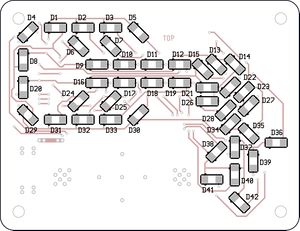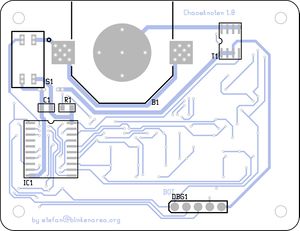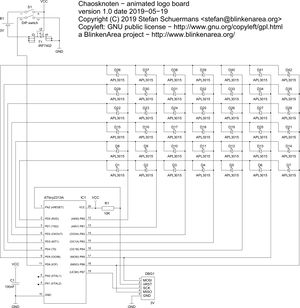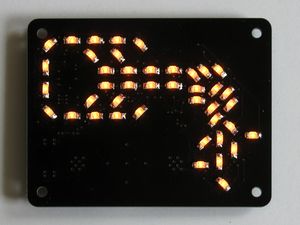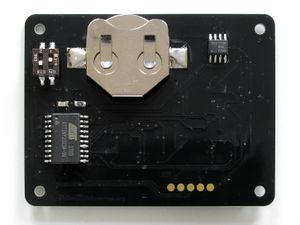ChaosknotenEnglish
From BlinkenArea Wiki
| project overview | |
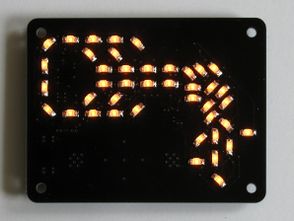
| |
| Year | 2019 |
| Number of pixels | 42 |
| Grayscales / Colors | 16 Graustufen (gamma 2.0) |
| Illuminant | SMD LEDs |
| Power input | 120mW |
| Contact person | Stefan Schuermans, ST |
| Project website | BlinkenArea Chaosknoten |
Chaosknoten - this is a small circuit board of 65 x 50mm, which uses 42 LEDs to show the official logo of logo of Chaos Computer Club. The orange LEDs display several animations using 16 brightness levels (gamma = 2.0). DThe board is powered by a single CR2032 button cell. On the backside there are two switches - one to turn it on and off, and the other one can be used to freeze the animation (freeze frame).
The logo is designed by Wau Holland. We are authorized by the Wau Holland Stiftung to provide this kit as long as we don't make any profit with it and we provide the layout information and software for free.
This project ist based on the bulb.
Downloads (firmware, layout, circuit layout)
Version 1.0.0
Images
- Open the Chaosknoten Instructions.
- Read pages 1 and 2 of the instructions, try to understand it and check if you have the complete list of parts.
- Solder the LEDs onto the front side as shown in the layout diagram on page 2. The black dots beside the LEDs in the diagram show you, where the green dots on the real LEDs shall point to. Your Soldering iron should have a temperature about 350 °C.
- Look at the layout of the backside on page 2 in the instructions.
- Take the resistor (tiny, dark, "1002" imprinted) and solder it on the position "Rq". The polarity (direction) doesn't matter.
- Solder the compasitor (tiny, brown, no imprint) on position "C1". The polarity (direction) doesn't matter.
- FET (klein, schawrz, 8 Pins) auf Position T1 einlöten (Der Punkt auf dem Chip gehört an die Seite, die im PDF mit dem Halbkreis gekennzeichnet ist.)
- Microcontroller (größer, schwarz, 20 Pins) auf Position IC1 einlöten (Der Punkt auf dem Chip gehört an die Seite, die im PDF mit dem Halbkreis gekennzeichnet ist.)
- Taster (scharz, zwei kleine weisse Hebel, 4 Pins) auf Position S1 einlöten. (der kleine Kringel markiert Pin 1. Pin 1 ist dort, wo die Zahl 1 aufgedruckt ist)
- Batteriehalter auf Position B1 einlöten
- Batterie einlegen
